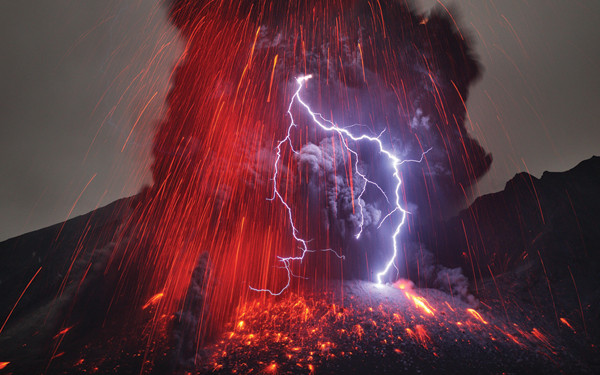
by Mary Caperton Morton Wednesday, March 19, 2014

Lightning was captured in images of the erupting Sakurajima Volcano in southern Japan in January 2013. Credit: Copyright Martin Rietze.
In A.D. 79, during the catastrophic eruption of Mount Vesuvius, Pliny the Younger wrote of a “blaze of lightning” illuminating the ash plume, marking the first recorded observation of volcanic lightning. Nearly 2,000 years later, scientists still know very little about how lightning is generated by volcanic eruptions, in large part because of the danger and difficulty in monitoring the phenomenon in the field. But a new apparatus for generating volcanic lightning in the lab may shed light on the subject.
“Volcanic lightning is associated with many different types of volcanoes and many different types of eruptions,” says Corrado Cimarelli, a volcanologist at the Ludwig Maximilian University in Munich, Germany, and lead author of the new study in Geology. However, even though volcanic lightning has been observed at slow-moving effusive eruptions in Hawaii, the phenomenon is most often associated with explosive eruptions with massive ash plumes, like the 2010 eruption of the Eyjafjallajökull Volcano in Iceland.
Studying lightning generated during volcanic eruptions has its obvious dangers, but even if the eruption can be observed from a safe vantage point, getting a good look at lightning strikes within the plume can be a challenge, says Tamsin Mather, a volcanologist at the University of Oxford in England who was not involved in the new study. “Explosive plumes are dense and opaque and so it can be very difficult to see what’s happening within the cloud even with special spectroscopic techniques,” she says.
Cimarelli’s team has taken a novel approach to studying volcanic lightning by generating a plume — complete with electrical activity — in the lab. Their apparatus consists of a highly pressurized shock tube that builds up pressures consistent with those observed during volcanic eruptions. By pressurizing mixtures of gases and particles and venting them through a nozzle into a large tank sitting at standard atmospheric pressure, the team simulated the decompressing rush of gas and ash that occurs at the mouth of a volcano during an eruption. “We are convinced that the fundamental process of charge and discharge is the same, no matter the scale,” Cimarelli says.
Using a high-speed camera to record the mini-blast and two antennae to monitor radio waves from the electrical discharges within the explosion, the team experimented with ash collected during the Eyjafjallajökull eruption, from Popocatépetl Volcano in Mexico and the Soufrière Hills Volcano in Montserrat, as well as a size-controlled mixture of glass beads. All of the samples generated sparks due to frictional charging between particles. The finer the particles, the more electricity was generated. Video of the simulated eruptions revealed that smaller particles were more likely to get caught up in turbulence around the nozzle, colliding with one another and generating the friction needed to produce sparks.
“As far as I’m aware, this is the first experiment to successfully generate volcanic lightning in the lab,” Mather says. “The real strength of this apparatus is that it allows the experimenters to control certain parameters and understand their effects. For example, the size distribution finding would be critically difficult to study in the field during an eruption.”
A better understanding of how lightning is generated by volcanoes could improve scientists’ understanding of eruptions, Cimarelli says. “These experiments allow us to systematically investigate which conditions are necessary for generating volcanic lightning and use this information to derive the properties of volcanic plumes such as mass eruption rate and fine ash content.” Such information could also possibly be used to predict the disruption of air traffic by fine ash particles, as occurred during the Eyjafjallajökull eruption in 2010.
The topic of volcanic lightning is also significant due to its potential implications for life on Earth, Mather says. Along with the lightning, “the cocktail of gases in a volcanic plume may have provided the conditions to synthesize the molecules that are the basic building blocks of life.”
Next, Cimarelli and colleagues plan to conduct more experiments and compare the results to data generated by modeling studies and data amassed in the field, most recently at Eyjafjallajökull in 2010. “We need to collect more field observations and to perform more experiments at different conditions,” Cimarelli says, “to better understand the range of conditions at which volcanic lightning occurs.”
© 2008-2021. All rights reserved. Any copying, redistribution or retransmission of any of the contents of this service without the expressed written permission of the American Geosciences Institute is expressly prohibited. Click here for all copyright requests.